The dream of continuous, semi-dedicated bus lanes on 82nd Avenue is alive; but if it is to become a reality, someone besides our regional transit agency will have to step up and make it happen. That’s the position made clear by TriMet General Manager Sam Desue and the agency’s Interim Director of Major Projects Michael Kiser at a meeting this morning.
The good news from the meeting is that Metro and the Portland Bureau of Transportation appear ready to step up.
At issue is how many miles of “business access and transit” (BAT) lanes should be built as part of the $350 million 82nd Avenue Transit Project. The two options under discussion are: “Some BAT,” which would build just three miles of bus lanes and leave busiest, central portion of the project corridor with standard lanes where buses are caught behind cars; and “More BAT, which would cost $8 million more and build seven continuous miles of bus lanes from SE Clatsop at the Multnomah/Clackamas county line to NE Lombard Street in the Cully neighborhood.
TriMet caused a stir last month when they released a staff recommendation memo opting for “Some BAT.” They have since walked back that recommendation, but after this morning’s meeting we have a clearer understanding of why our transit agency is choosing the option with less transit: According to Desue and Kiser, a more expensive and ambitious project could jeopardize the budget and timeline. With federal funding, there can be no diversion from the timeline and TriMet wants to take the safest option.
At the outset of the project’s Policy and Budget Committee meeting this morning, Desue said he’s aware the community is, “advocating for a bold vision for 82nd Avenue.” But, he added, “For those of you who know construction, scope is more than just a word, it’s our foundation.”
“Scope defines what we will build, how we will build it, and it serves our promise to deliver on that vision,” he continued. “To keep that promise, we need a budget that matches the scope and a timeline for delivery. Any adjustments to the scope, schedule or budget make project delivery more difficult. So that’s why our direction to the project team is always: scope a project that we can build.”
Desue then referred to the bus lane decision as one TriMet “cannot make alone because of the impact on scope, schedule and budget,” and that, “the project has its limits, but our investments can be leveragd by the good work you all do” (where the “you” referred to project partners at Metro, the Portland Bureau of Transportation and the Oregon Department of Transportation).
Kiser has echoed this sentiment. He maintains that the staff recommendation for “Some BAT” reflects the reality of what TriMet can deliver by themselves. In reference to the recommendation at this morning’s meeting he said it, “Didn’t necessarily fit the aspirational expectations of some partners, and also individuals in the community as well.”
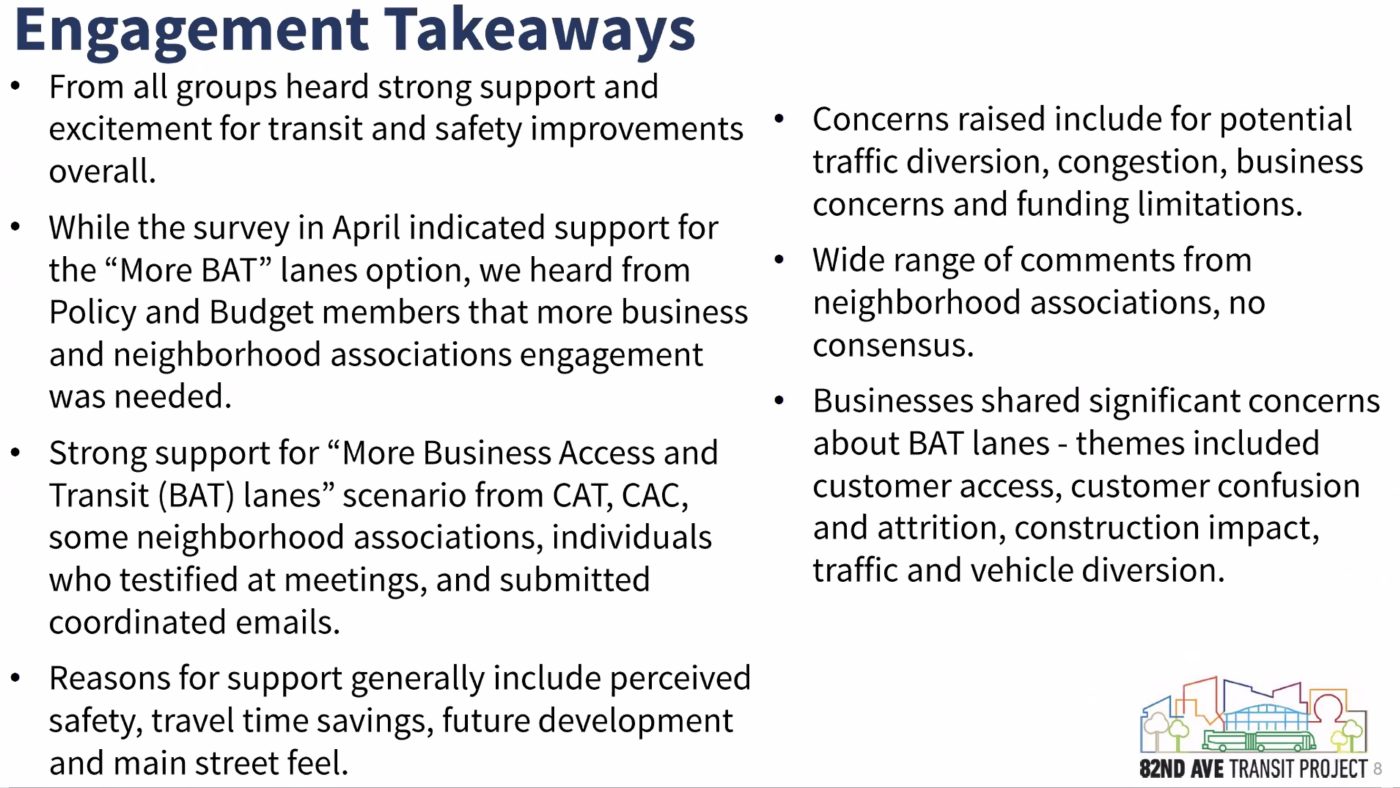
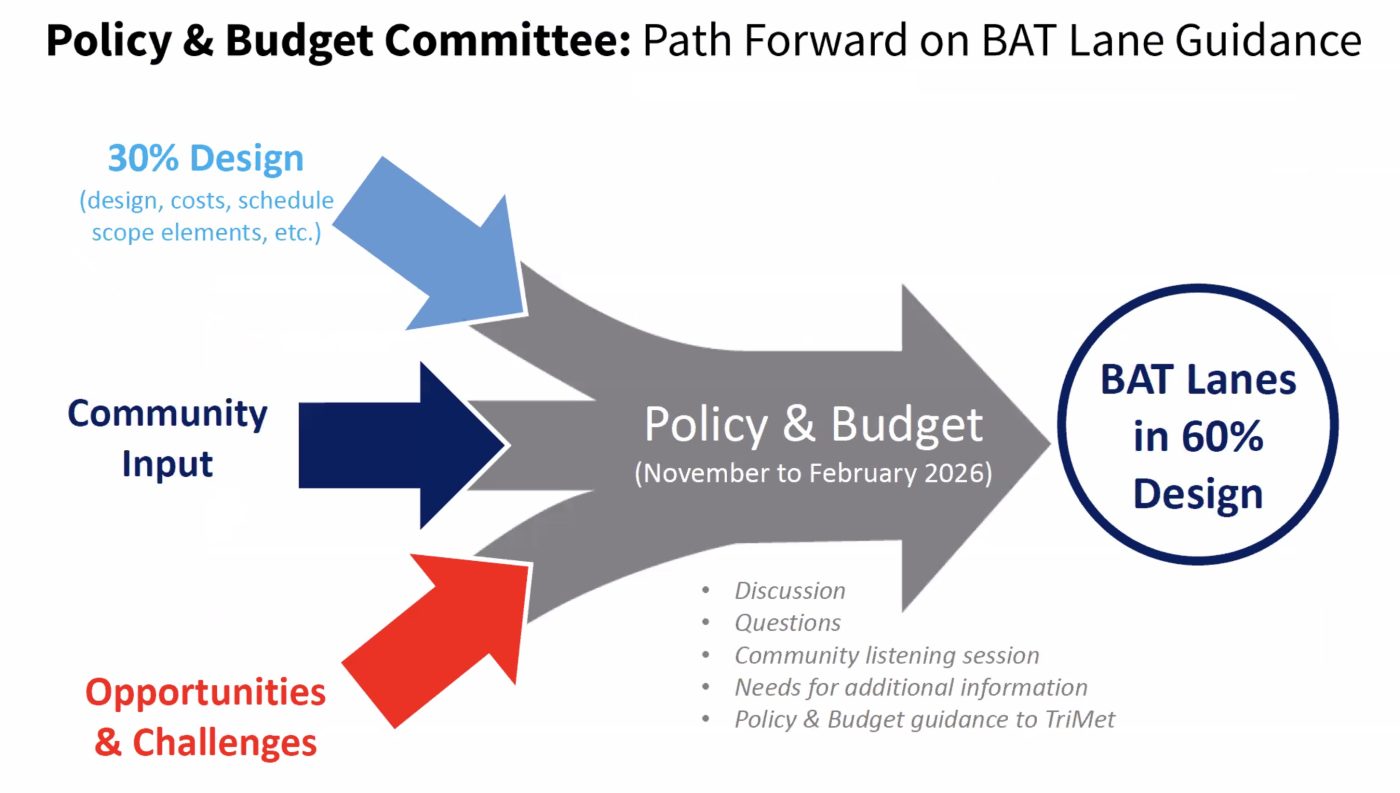
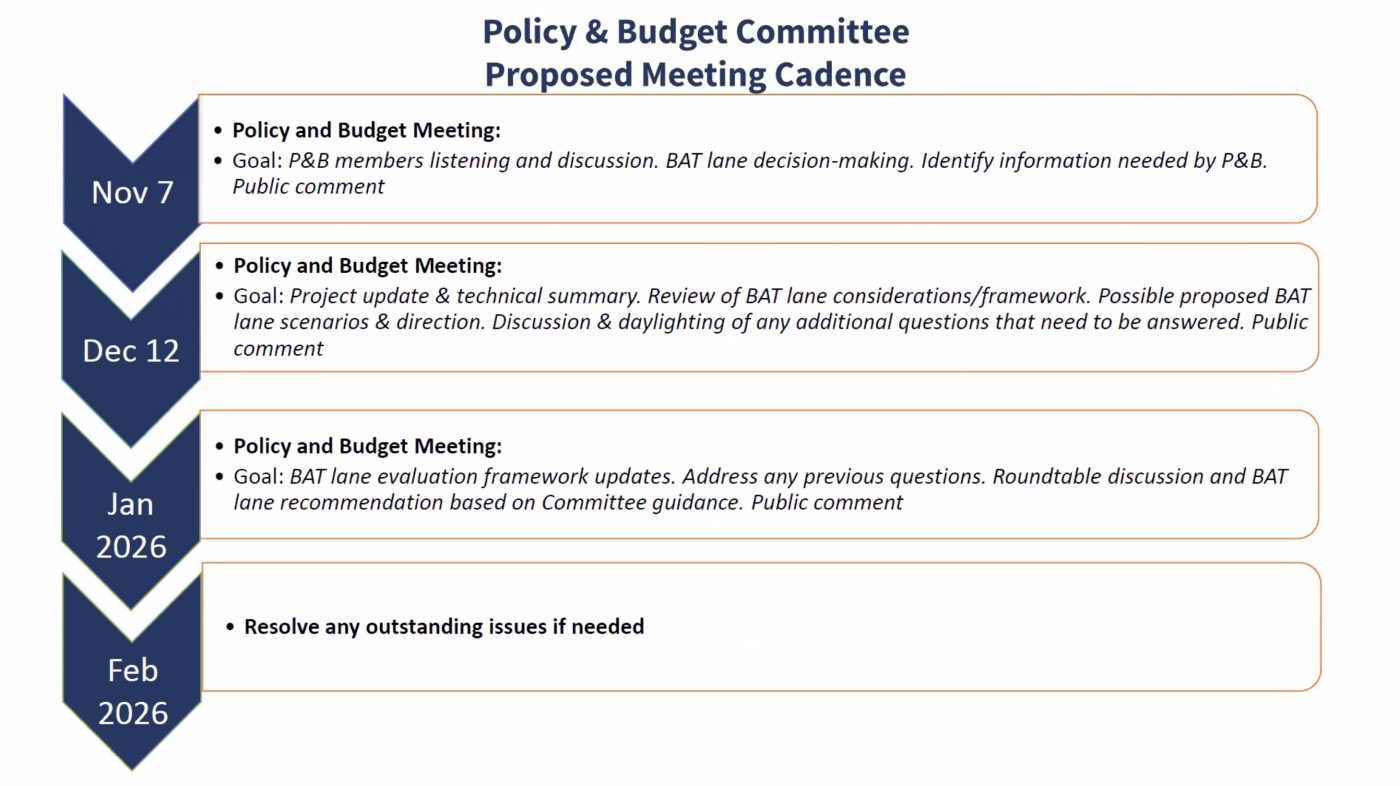

The good news is that TriMet is giving more time for this issue to be debated before a final decision (expected by February 2026) will be made.
Metro Councilor and Policy and Budget Committee member Duncan Hwang, who was one of the people caught off-guard by TriMet’s initial staff recommendation, urged folks to not settle for compromised transit. He sees better transit as vital to the future of 82nd Avenue, especially as development hastens in the near future. “With the new 82nd Avenue TIF [tax increment financing] district, 40% of that [revenue] goes to affordable housing — so you’re going to see 30 more buildings along the corridor over over the coming decade or two,” Hwang said.
“So how do we create the best transit system to support that new vision that’s coming?…I think that requires us to be ambitious at this moment,” he added.
Hwang made it clear he’s ready to advocate for more funding from Metro if that’s what it takes. “Bring us that budget,” he said. “We want the corridor of our dreams, and I don’t want to cut things off before we’ve had that full conversation.”
PBOT Director Millicent Williams also sounded ready to find more money to build continuous bus lanes. “Yes that will be more expensive,” she said. “But that’s what we’re here to do, to help raise money.” Williams also pointed out that the extra $8-10 million needed for the “More BAT” option, “is not a lot of money.” “We can figure out how to raise $10 million if it’s a $350 million investment.”
Williams sees this not just as a question of dollars and cents, but as a symbol of what Portland stands for. “The issue really is: What are we saying as a region? What is the policy statement that we’re making by the choices that we’re putting forward? It’s less about the money, and more about what are we saying about the community that has been historically underserved and underinvested in, and how are we meeting this moment?”
TriMet is still gathering feedback from businesses along 82nd about the bus lanes and plans to present a full community engagement report at the December 12th Policy and Budget Committee meeting. Also at that meeting TriMet and ODOT will share more details about diversion analysis and other technical metrics that could influence the decision. An ODOT rep on the committee pointed out that ODOT has to issue a permit to PBOT because the lane decision will impact two state highways that intersect with 82nd: US 30 (NE Lombard) and US 26 (SE Powell).
The next meeting for this project is a Community Advisory Committee meeting on November 19th. Learn more at the project website.

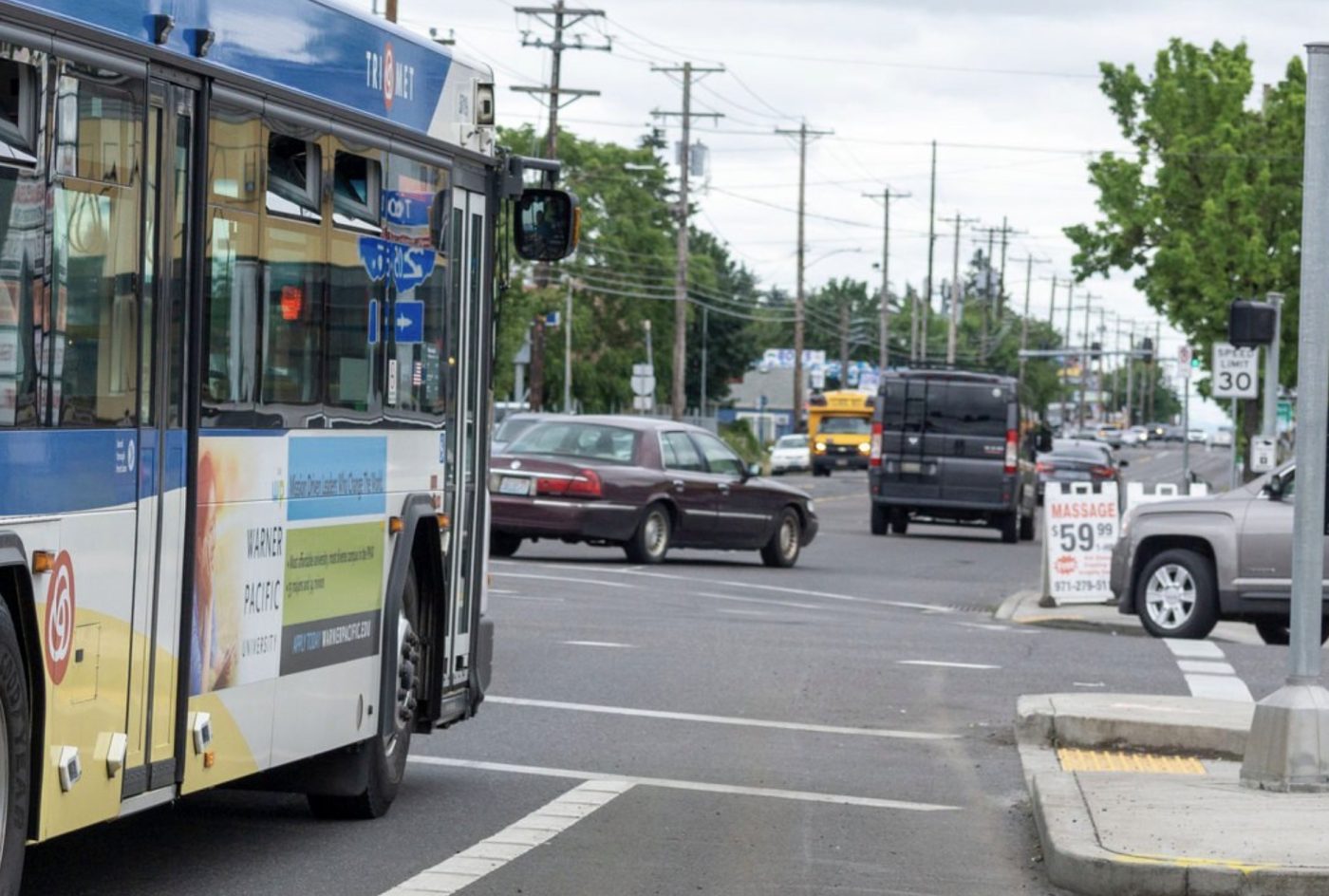

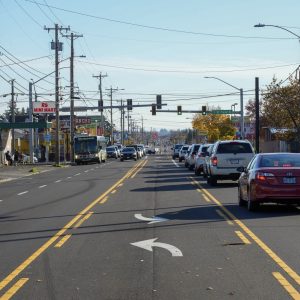
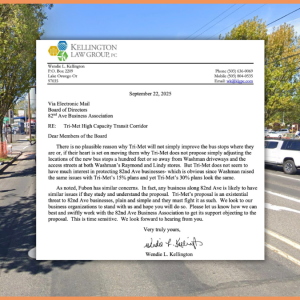

Thanks for reading.
BikePortland has served this community with independent community journalism since 2005. We rely on subscriptions from readers like you to survive. Your financial support is vital in keeping this valuable resource alive and well.
Please subscribe today to strengthen and expand our work.
It is astonishing and dubious that TriMet claims it is running out of time.
If TriMet had chosen full BRT, or a center running option, then surely they would have run out of time, right?
It appears that some people are not concerned about the number of deaths, crashes, incidents of mayhem, and assault with a deadly vehicle that occurred on 82nd that led to jurisdictional transfer.
PBOT has spent bunch of money on 82nd Ave to make it safer.
Now it is time to make transit more reliable.
PBOT & METRO have goals to increase transit ridership.
Coddling the business community so that more death will continue to occur is the height of irresponsible leadership.
when Lynn Peterson puts out an RTP that does not meet the regions goals, I am not sure why she is present at these meetings being critical of TriMet. She appears to be unaware that PBOT has installed medians & pedestrian islands on 82nd. PBOT will continue to install medians and islands as part of their 82nd Ave project.
https://www.portland.gov/transportation/pbot-projects/construction/82nd-avenue-major-maintenance
https://www.portland.gov/transportation/pbot-projects/construction/82nd-avenue-crossings-project
And the banal turpitude of ODOT to suggest that diversion to I-205 might be a problem and yet the DEATH ON 82nd Ave WAS NEVER A PROBLEM to ODOT.
Washman – “transit is a detriment to our business.”
how about death of other people? meh. crickets.
same for Metro Chamber; they clearly think money is more important than people.
The “some bat” plan seems weird. The bus riders will still be slowed by car traffic. Motorists and business owners will be mad at the road changes and lane restrictions.
I really wish it were clearer who the pressure points for this were. A partial BAT seems like a really bad plan, without the advantages which would make “normal” people consider taking it.
I often come back to this quote:
“You don’t wait for the sidewalk. You don’t check an app to see if it’s working. You don’t wonder if it’s meant for someone else. Sidewalks are just there—always available, always on. And when they’re well-designed, you barely notice them. They quietly support everything: commerce, mobility, safety, health, and freedom of movement. Sidewalks don’t require instructions. They’re intuitive. Step on, move forward.
That’s the framing we need for local bus service. A well-run bus system is an express sidewalk—a piece of infrastructure that dramatically expands the number of destinations within walking distance.”
https://www.urbanismspeakeasy.com/p/should-we-treat-the-local-bus-like
“You don’t wait for the sidewalk.”
Trying to replicate the attributes of an insert slab of concrete with complex machinery, lots of diesel fuel, and government workers is bound to fail.
Perhaps instead we should replace TriMet with bikes, which have pretty much the same attributes you listed, are much cheaper, and are available today.
Trimet leadership loves to lose.
New Trimet bus slogan: “Get in losers, we’re ridding the transit death spiral to irrelevance.”
*riding